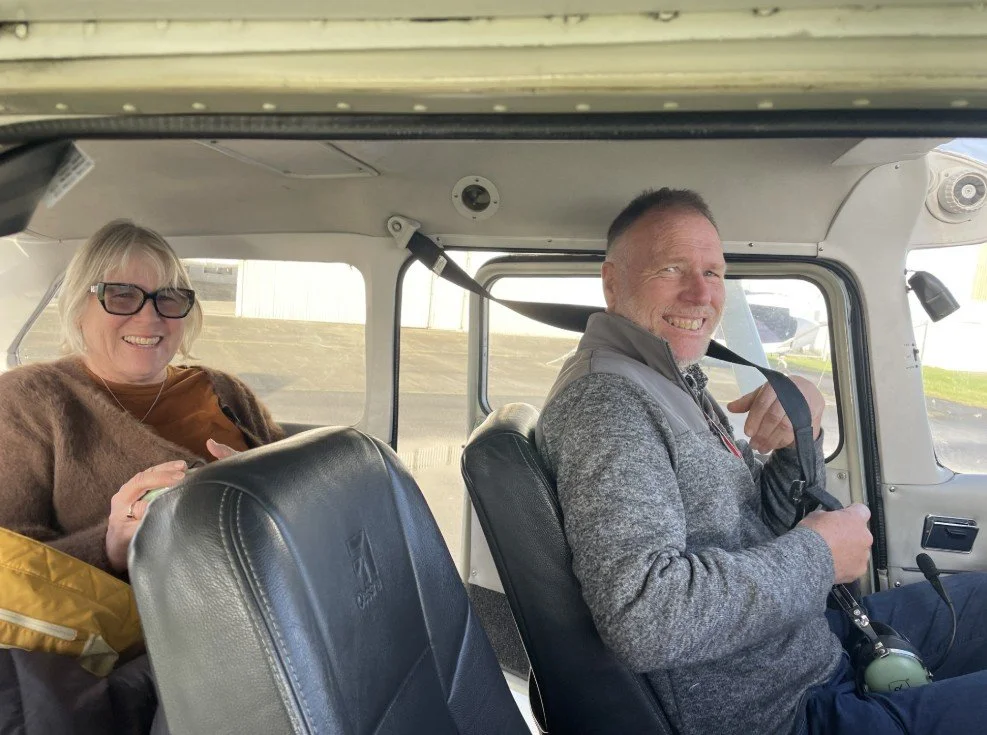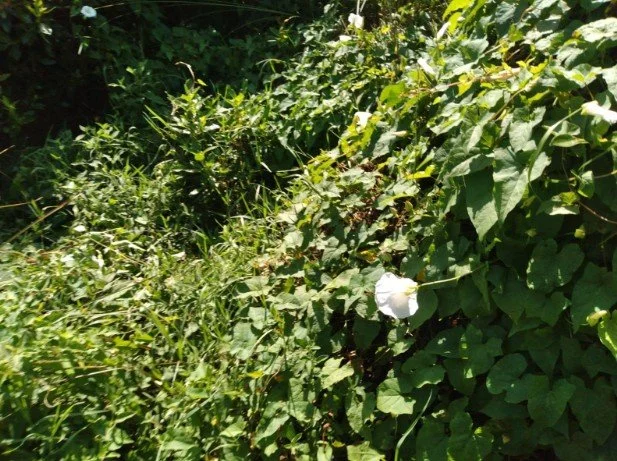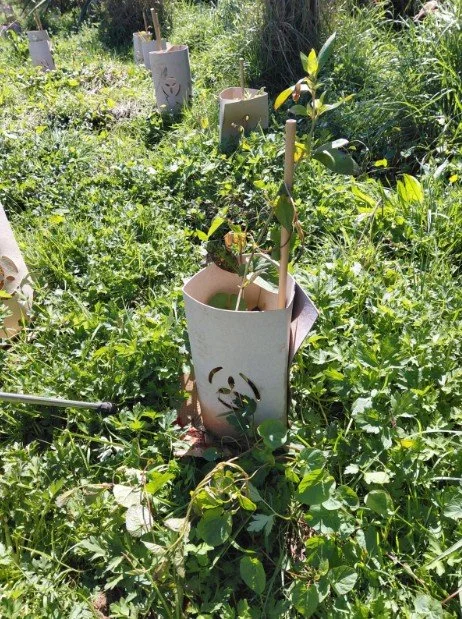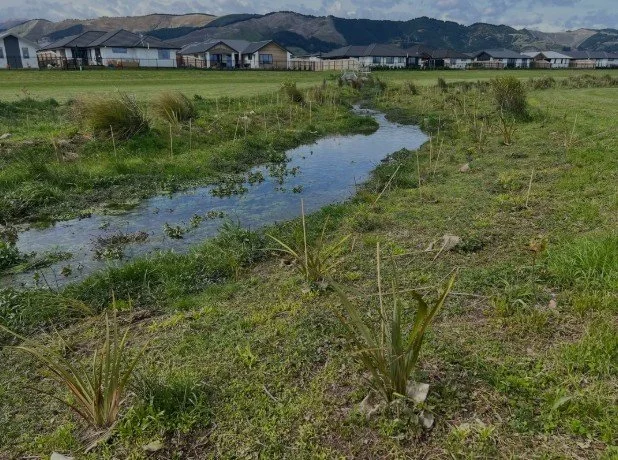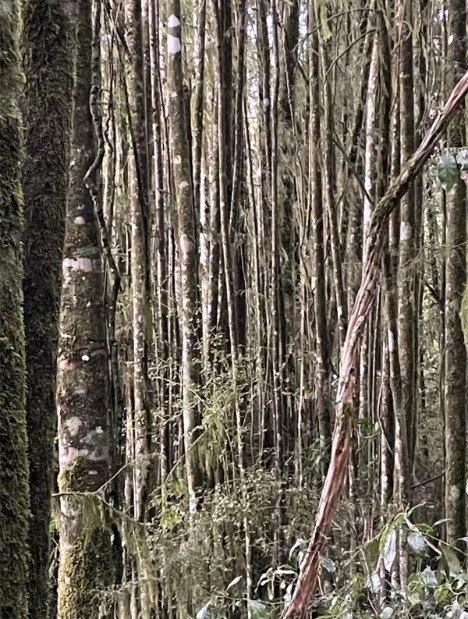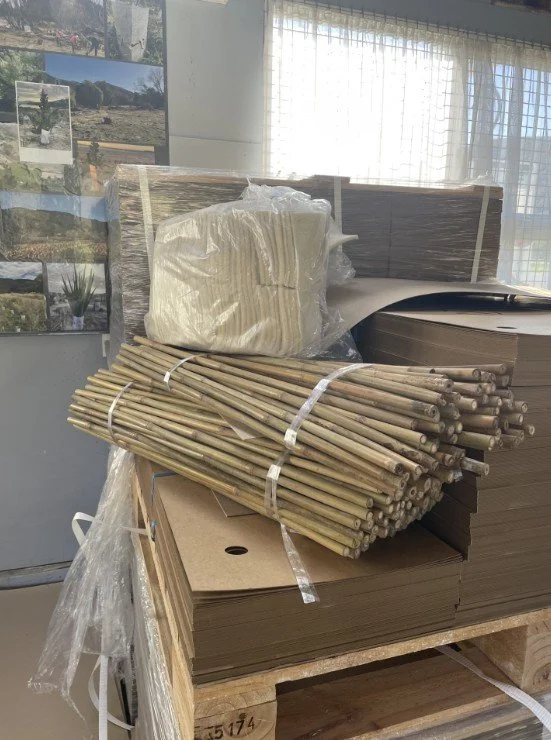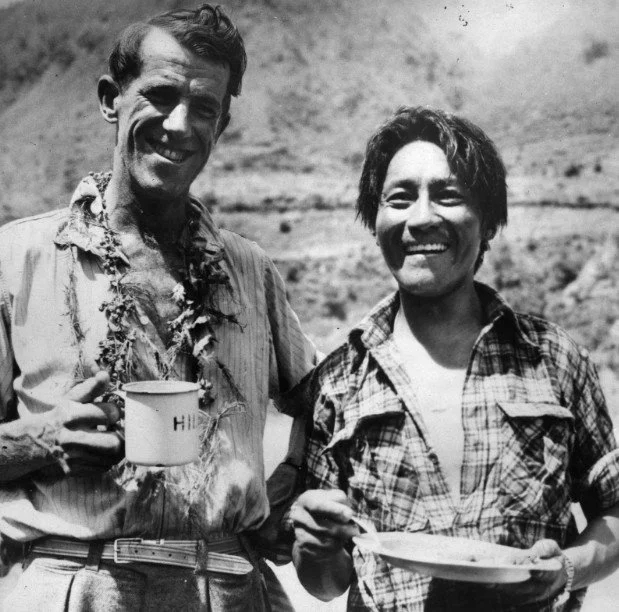FuturEcology & EmGuard ™ October 2025
By Jan Fryer
I’m definitely sure that at this time of year, the clock speeds up. I know we did lose an hour when the clocks leapt forward for daylight saving, but I think I lost a week somewhere.
Driving through Blenheim a week or so ago, spring had well and truly sprung. Grapevines were covered in leaf, but then last week they were threatened with frosts again.
It has certainly been a fickle spring. We have noticed things are starting to dry out. If you haven’t got your plants in yet, then a concentrated effort is needed during October. Plants need to establish their root system in these early days of spring to ensure they thrive during the summer. Late plantings need to either be mulched or watered regularly to encourage root growth, to ensure they can cope with dry summer spells.
I was lucky enough to snatch a few days to walk the Nydia Bay Track in the Marlborough Sounds. It goes from Kaiuma to Duncan Bay for 27 kms in total, over a couple of saddles, so there was a bit of uphill to navigate with my somewhat unfit body. Part of the walk is through cut-over forest, pine trees and second growth bush. However, the walk out to Duncan Bay goes through some lovely mature forest with nīkau and punga being a real feature. The flowering clematis was all out as well, which looks stunning in the tree tops.
The bay itself is a typical Sounds bay with plenty of water activities to do. We stayed at On The Track Lodge | Nydia Bay Accommodation | Marlborough Sounds, which had some lovely, quirky accommodation. There were kayaks and paddleboards to use and best of all, it was fully catered for. It was a bit cold and chilly for me to venture out onto the water, but a couple of our hardy crew did and had a wonderful explore of the bay. There are jetties to jump off, waterfalls to find, eels to feed and freshwater pools to swim in, if it is warm enough!
There is also a DOC Lodge that can be hired to stay in. If you want a group trip, it is worth looking into. Stay an extra day in the bay to allow for some exploring.
There are boat options from Havelock, including the Mail Boat, if you are not so keen on walking.
As summer approaches, it is nice to think we can put on our walking boots and get out a bit more into the wonderful natural environment we are so lucky to have in New Zealand.
FuturEcology Update
By Jan Fryer
As we mentioned last month, change seems to be the theme of our lives.
We live in interesting times at the moment. Nelson has taken a real hit in its manufacturing sector in the last month or so, but it is only the big companies making the headlines.
We at FuturEcology have not been immune to the economic challenges of the present time, particularly in the conservation sector. As a result, we have been looking seriously at what we do, how we do it, why we do it and what our future shape may be. Robert and I are not getting any younger and have been looking at what retirement might look like for us in the not-too-distant future. We all know that that you can’t buy time back. How true is that!
Some of our major projects are coming to their natural end as landowners take over the on-going maintenance of their regeneration projects. Other projects have been delayed due to the current economic climate. We still have a wide variety of interesting and varied work ahead of us, but it takes a lot of work and dollars to run a business. Both of us know that we are ready to slow down a bit. We did float the option of selling the business and although there was some interest, the right person didn’t come along. Our baby is too precious to just let go to anyone😊
As staff have moved into other opportunities, we have not replaced them in the last year, which has meant we have used local contractors and temp agencies to cover some of our busy times. This has worked well, so we have decided to move more into that model of operating. This will give us a bit more time to focus on the projects we enjoy, and on continuing to sell EmGuards around the country. What a great job they do in ensuring plants thrive. We also want to focus more on imparting 40+ years of wisdom and experience in the field of conservation and ecology, in whatever form that may take.
As a result, our remaining permanent staff are moving on to new opportunities in November, and we are shifting from our current site to a purpose-built facility on our own property.
Our contact details remain the same and our new address is 84 Ross Road, Hira from the 7th November.
We will continue to provide all the services we have in the previous 11 years and wish to thank you all for your support over that time. We look forward to continuing to work with many of you and to see your ideas and projects brought to life and flourishing.
Please keep us in mind for any interesting projects you may have planned that have a legacy focus.
Robert re-discovering his pilot’s license.
Weed of the Month
Picture of convolvulus and its white flower.
Convolvulus - Convolvulus arvensis
By Evelyn Nashiro
As early spring brings warmer days and new growth, it's not just native plants that are thriving. Invasive weeds like convolvulus, often known as bindweed, are also making a fast comeback. This fast-growing climber is already being spotted smothering young native trees, threatening their first burst of spring growth.
Convolvulus grows quickly, sending out long, twining stems that wrap around shrubs and trees, blocking sunlight and weighing down branches. Leaves are linear to arrow-shaped and alternate. Flowers are generally white and funnel shaped. If left unchecked, it can overwhelm and eventually kill young native trees. Its roots are deep and rhizomatous, making manual control difficult. It can be spread by both seed, or rhizomes and root fragments.
Convolvulus in action, climbing on everything in its way.
Now is the ideal time to act! Controlling convolvulus in early spring, before it fully establishes and spreads, is easier and more effective than trying to manage it later in the season when the trees are covered with it. Hand-releasing, careful spot spraying, or cutting and removing the vines at the base can help keep it under control, but timing is crucial!
Dig out roots and dispose of them to landfill if possible. Cut stems and leave vines to die in trees. Pull or cut away from plants. Spray with a mix of 1% glyphosate. We have found that spraying in the heat of the day is more effective than an early morning spray.
By dealing with convolvulus early, we give our native plantings the best chance to thrive without competition from this fast-growing invader. A small effort now can prevent a much bigger problem in summer
Plant of the Month
Nīkau Rhopalostylis sapida
By Jan Fryer
This would have to be one of my favourite trees and I was treated to the joy of them on the Nydia Track last week.
They are New Zealand’s only native palm species and are the southern-most member of the palm family. Most people associate palm trees with tropical or sub-tropical locations, which is why it is so nice to see them thriving here. It is found in the North Island and as far south as Okarito on the West Coast and Banks Peninsula on the East Coast in the South Island.
The nīkau palm grows to between 10-15m tall with a circular trunk, identified by its evenly spaced rings, which are the scars where dead fronds of up to 3m long have fallen off. They are very slow growing, taking between 40-50 years to form a trunk and 200 years to reach maturity.
It flowers throughout the year, with large clusters of mauve flowers that come from the base of the lowest frond. The flowers are nectar filled and sticky, proving a great attraction to bees. Birds such as tui, bellbirds and silver eyes also feast on the nectar.
Bright red berries follow, that take up to a year to ripen and are a favourite food source of kereru/wood pigeon and kaka.
The outer portion of the fronds were used by Māori to make containers and storage pots. The leaves were used for thatching, wrapping food before cooking, woven into useful items and the berries turned into beads for necklaces.
Parts of the tree, including the unripe flower and the heart of the developing leaves, can be eaten.
Threats include modification of their coastal and lowland habitats and introduced mammals, that eat the flowers and berries.
There are magnificent stands of nīkau on the West Coast, so if you find your way there this summer, make the most of enjoying these wonderful trees.
Projects Update
by Evelyn Nashiro
Native plants thriving at Borck Creek
Over the past two years, we have witnessed impressive growth of native plants at Borck Creek. Despite facing several flooding events, these native species have been resilient and thrived beside the Creek.
During this time, the team at FuturEcology have dedicated many hours of maintenance efforts. We have focused on hand releasing and scrub barring around the native plants, so they don’t have to compete with the long and fast-growing pasture grasses that were a feature of the site. Also, the control of willow has been crucial to keep the open landscape along the Creek.
One of the standout successes in this project has been the growth of native grasses (particularly Carex secta and harakeke) as you can see in the pictures below. These species, long adapted to flood conditions, have proven to be incredibly resilient. Their deep root systems help stabilise the soil and reduce erosion on the Creek banks.
Borck Creek plays a crucial role in the life cycle of tuna (New Zealand eel), an iconic species of Aotearoa. The Creek’s healthy environment serves as a vital nursery for juvenile tuna, providing the calm and sheltered waters they need to grow in before making their way to the sea. The restoration of native plants along Borck Creek’s banks and riparian zones has directly contributed to improving water quality, reducing sedimentation and maintaining the clear, slow-moving waters.
Borck Creek reminds us of the resilience of Aotearoa’s native flora. Despite challenges like flooding, the persistence of native grasses and other key species shows how vital and adaptable these plants are to the ecosystem.
Borck Creek in 2023, when the team at FuturEcology started planting.
Borck Creek in September 2025.
Plant spacing discussion
by Robert Fryer
We frequently end up in discussions regarding plant spacings. What is the ideal plant spacing? This is of course like asking “How long is a piece of string?” There is no right answer for everything, but there is a right answer for each particular project. We do want to maximise the ground we cover and get the most out of as few plants as possible. Therefore, getting the correct spacing for your project is critical to avoid wasted time and resources, yet achieve what you are looking for.
Typically, we space plants close together to shade the ground as quickly as possible. Very often we are trying to convert pasture into forest and to do that, we need to kill the grass. Close plant spacing will achieve this much quicker than wide spacing. We have seen wide spacings in pasture that have led to project failure, as the plants have never out competed the grass.
We often consider a spacing from 1.2 m to 1.5 m for planting ex-pasture. A wider spacing can work in different ground conditions, such as ex-forestry, but you really need to understand the different growing habits, once those plants are in the ground.
We have been fortunate to be able to observe a planting trial locally, that tested a range of spacings. Interestingly, the closest spacings (around 400mm) appeared to outpace wider spacings in the short term. We are unsure why, but perhaps there is some benefit as roots meet, mingle and share resources. I am sure there is a lot going on subsurface that we do not yet fully understand.
Another commonly held belief is that if plants are too close together, they will not grow. We are told by some that close spacing does not happen in a forest. I would encourage you to have a look in an old forest that has not been damaged, and look at the natural spacing of trees. It is not uncommon to see two old forest trees tightly sharing the same square metre of ground. Forests seem to have a way of sorting themselves out and each tree maximising its own potential.
Natural regeneration (Murchison).
Note how close the trees are together.
Friends forever (Murchison).
Above all, don’t hold back, just keep planting. Think about your spacings and what you are trying to achieve. Make sure you keep your lines random as nature doesn’t do straight lines. The sooner the ground is effectively shaded, the sooner the natural magic happens.
EmGuard Update
By Jan Fryer
My shoulders sure know that I have been moving a ton or three of EmGuards in the past few weeks. Thanks to everyone who has made the most of the spring weather to get plants in the ground. We had a bit of a run on guards, but supplies are back on track and we have good numbers in stock.
If you need larger quantities (3000+), please let us know in plenty of time, as we have a four week lead in time from the factory. We definitely try to hold good numbers on hand, but based on the run I had last week, sometimes it is difficult to keep up.
One of our contractors did a planting trial, which we have talked about in past newsletters.
Here are a couple of the latest pictures from the trial, showing the difference where no guards were used, compared to the area where guards were used. About 65% of the plants were lost in the first two nights after planting, in the unguarded area!
No Guards.
All Guarded.
You can order online via our website www.futurecology.co.nz or drop us an email.
Jan’s details are:
Jan@futurecology.co.nz
Ph: 027 497 5838
EmGuards ready and waiting for your spring planting
Interesting Snippets
What we’ve been watching
by Jan Fryer
Prime Minister
No matter what your political stripe, this documentary chronicles Dame Jacinda Adern’s tenure as New Zealand’s 40th Prime Minister, during some of the biggest crises New Zealand has faced, and in such a short period of time.
It is not so much about politics, but much more about the impact of carrying such responsibility, particularly when we were dealt one blow after another as a country. The mosque shootings, White Island, the pandemic, the protests in Parliament grounds. Jacinda faced all this, while juggling being a new mother.
The documentary chronicles a very challenging time in New Zealand’s history, but also the impact of being in a leadership role during times of crisis. The impact it had on her family, herself, her wider circle and the country.
In her words “ I was very emotional watching it. I credit the storytellers for it. I hoped the film would humanise politicians, those who are public servants, and leadership, but I never thought it would humanise me. When I watched it, I just saw myself as someone trying to do their best”
I certainly believe we need to be reminded of what it is to be human, the importance of leadership and just what the country faced during that time. This documentary did it in spades for me.
Clarke Gayford on the making of 'Prime Minister' | RNZ
What we’ve been listening to:
Available on Spotify
Edmund Hillary: A Biography.
by Dan Arnold
This is the incredible story of Sir Edmund Hillary, from adventurous beginnings in New Zealand to conquering Everest and changing lives in the Himalayas.
This inspiring podcast shares the highs, challenges and lasting impact of a true explorer.
Podcasts are a real highlight for all our team, as we often tackle the mundane but vital work of weed control in many of our restoration projects. We all compare notes and stories that have inspired us on a very regular basis.
Conclusion:
By Jan Fryer
This past month has certainly been a steep learning curve for me. Learning how to use new software, including Canva and Smart Draw, have been just some of my challenges. Emma used to be our whiz kid with those things – the younger generation.
We’ve been doing some interesting reports and surveys on such things as wetland delineation surveys, a grey willow infestation survey, an assessment of environmental impacts of using wastewater for irrigation, and such-like.
It is what I really like about our business. No two days are the same, and there is learning of new things to be done every single day.
We always appreciate the morning tea conversations in the team about things they have discovered or learnt about recently.
Life is definitely a journey of learning. Community connection, expanding knowledge and having a purpose are all identified as life affirming activities.
May you enjoy these activities in your daily life.
If you have any projects in mind and would like to talk further, give us a call or pop in and see us.
We look forward to hearing from you!


